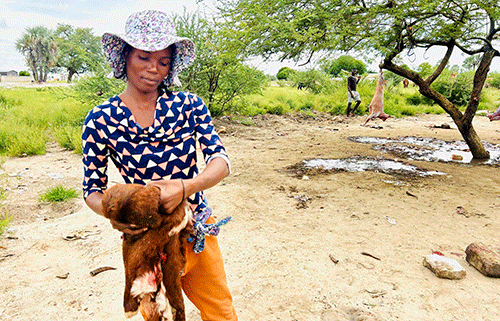OMPUMBU – In the blazing heat of Oshakati, Ompumbu area, where goats are slaughtered and sold daily, a quiet struggle for survival plays out behind the scenes among the waste heaps and bloodied soil.
Women here shared how they survive on abandoned goat skin.
Their stories highlight the harsh realities faced by Namibia’s most vulnerable.
While others walk away with meat and profits, these women remain behind – scraping by with the leftovers.
32-year-old Martha Shapumba bends over discarded goat skin and intestines, salvaging what others toss away without a second thought.
Decades ago, goat skin was consumed by families throughout Namibia. At the time, this was considered a norm – especially for those with no direct access to meat.
But for Shapumba and others, it is not really a choice, but more of a necessity. Originally from Oshikango location, she is a single mother of a seven-month-old baby, whom she carries on her back as she searches the grounds.
Her hands are rough from the work, her feet swollen from walking, and her eyes weary.
“I never imagined my life would come to this,” Shapumba said, gently rocking her baby.
“There are days I find nothing. But I must try. My child needs to eat,” she stated.
She narrated that she boils the intestines and skin over an open fire.
Without a steady income, she survives on the kindness of strangers, and what she can collect from the waste piles at Ompumbu.
“Some people take along their goat skins for leather, But for us, it’s food. That’s all we have,” she stated.
Shapumba added that on some days, a good Samaritan might offer her a goat head or a few trotters.
This, she sells to buy a bag of maize meal. That, she says, is a good day.
“Even if I could sell vetkoek or sweep somewhere, I would do it. I just want a chance,” she revealed.
Just a few metres away, 56-year-old Saima Shilongo shares a similar story.
Without the government pension or a family to support her, she relies on what others discard.
“I come here every morning. Sometimes, I find something. Sometimes, I go home empty-handed,” she said with her voice trembling not just with age, but exhaustion.
Despite their dire circumstances, the women hold hope for a better future. Sapolo Johannes, one of the local goat sellers at Ompumbu, acknowledged the women’s presence.
“They wake up early – even before us. We sometimes give them tenders to wash intestines for customers. They use what they can to get a piece of bread,” he said.


